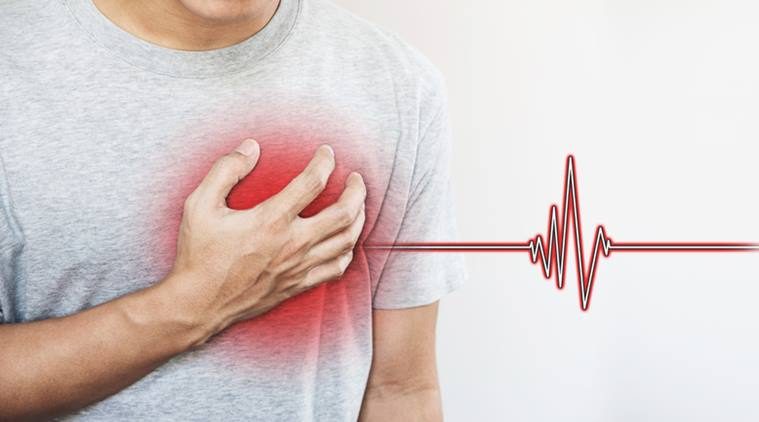Dr Jaswal listed the factors that usually cause heart attack. The list included high blood pressure, diabetes, smoking, increased cholesterol, central obesity, lack of exercise, lack of intake of fruits and vegetables and psycho-social stress.
Changing lifestyle, predisposition to genetic diseases, junk food, consumption of food rich in fats and lack of exercise are the reasons that has made India the diabetes and cardiac diseases capital of the world.
Delivering a health talk to the Senior Residents Welfare Association of Panchkula on Monday, Dr RK Jaswal shared facts and statistics about the scenario of cardiac diseases in India, which has changed drastically in the past 30 years. “We call a heart young when a person is of less than 45 years. While around 20 years back, not even 10 out of 100 people who walked into a hospital with a heart-attack had a young heart, now we get more than five patients per month who are aged less than 40,” said Dr Jaswal who is the head of the Cardiology department at a hospital in Mohali.
An epidemic
The doctor said that a 95-year-old person has a better heart than today’s 40-year-olds. “The young who walk in, have hearts so weak, that they would not even be able to sustain an angioplasty, a procedure to restore blood flow to the artery. The problem is so dire that every third person in India dies of heart attack. It has become the epidemic of India,” said Dr Jaswal. At least 67 per cent of the total cases of heart disease in India are among those aged less than 55, while in the west, cases below 55 are considered rare.
Of the total deaths in India, as many as 35 per cent happen due to heart attacks as compared to USA’s death rate due to heart attack at 12 per cent and China’s at 20 per cent. Moreover, 10 per cent of the total adult population of India, amounting to six crore has some or the other heart issue. As many as 91 people per hour, which translates into three people per two minutes, die due to heart diseases.
Why is the rate increasing?
According to Dr Jaswal, affects of rapid urbanisation and industrialisation are major factors contributing to the increased occurence of heart diseases. “The increase is due to rise in levels of smoking and consumption of alcohol, due to changing lifestyles. This, coupled with unhealthy eating poses more threat. Indian culture promotes drinking in large quantities while the westerners drink a peg or two. The Indians have deep fried snacks that accompany their drinks. Patiala pegs need to be toned down,” he laughed.
Higher blood pressure, sugar and cholesterol issues are markers of the coming heart diseases. They put more pressure on the heart. “People think it is alright to take their BP medication only after they get a headache. But in reality these headaches are dangerous. It is only after the BP reaches 180 mmHg, does a headache start. This impacts your heart to a great extent,” said the doctor.
Fat comes with risk
“As South Asians, we have the highest pre-disposition to our family’s genetics. Indians, thus, most get heart attacks 10 years earlier as compared to the west. The number has risen so high, that of all the heart patients, as many as 25 per cent lie below the age of 40,” said Dr Jaswal. “Fat deposit in and around our stomach is the biggest killer of all. As Indians, we get most of our fat on the area. Visceral fat or belly fat found inside abdomen, wraps around your internal organs. The excess of it can lead to a higher risk of Type 2 diabetes, insulin resistance and heart diseases,” he added.
According to the WHO, waist size among men must be less than 36 inches, while among women, it should be less than 32 inches.
Probable factors
Dr Jaswal listed the factors that usually cause heart attack. The list included high blood pressure, diabetes, smoking, increased cholesterol, central obesity, lack of exercise, lack of intake of fruits and vegetables and psycho-social stress.
“Smokers risk a heart attack more than 2-3 times as compared to non-smokers. The psycho-social stress that mostly happens because of job stress, lack of social support, anger and depression is also a big factor,” said Dr Jaswal. He further added that Type A personalities, who are defined as high-achieving “workaholics” identified as outgoing, ambitious, rigidly organised, highly status-conscious, sensitive, impatient, anxious, proactive, and concerned with time management, according to the data, are the most-stressed and have high chances of getting heart attacks. “However, sudden changes for them are not suggested as it has also been found that such people, get more stressed by not doing what they please to do”, said Dr Jaswal.
Prevention
Pointing out that “though it is a growing epidemic, it is a preventable one,” Dr Jaswal suggested easy, cheap and regular routines that could be incorporated by individuals to prevent heart diseases. He said, at least 30 minutes of moderate exercise goes a long way to keep one fit. Physical activities in daily life, such as climbing stairs instead of taking the elevator also helps. Reduction of stress through yoga and meditation is also a tested way for keeping fit, both mentally and physically.
Avoiding dairy products, like ghee and butter keeps cholesterol levels low. Taking in required amounts of MUFA and PUFA, that includes olive oil, peanut oil, cereals, soybean oil, sunflower oil, mustard oil, corn oil and walnuts also helps. Though, keeping a balance is necessary. Restricting the consumption of fast food or packaged food to once a month is the way to go, the doctor said. High levels of alcohol, tobacco and smoking is dangerous and ones diet should have a healthy combination of food that is rich in protein, fiber and vitamins.
Source: Read Full Article





